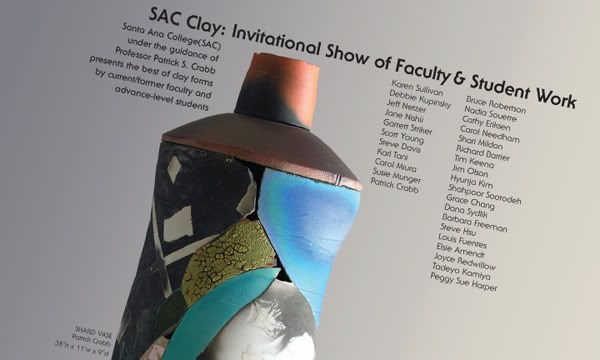The best of clay forms by
After many years, the ceramic artists of of Santa Ana College (SAC) are back at Chemers Gallery. You won't want to miss the opportunity to see this exciting and diverse exhibit. The show has been curated by SAC professor, Patrick S. Crabb, whose work is collected widely throughout the US and abroad. The work of twenty-two advanced level students and eight faculty members will be featured.
September 6-20, 2008
Artists' Opening reception:
Saturday, September 6, 2008
5:00-8:00pm
CHEMERS GALLERY
Enderle Center
17300 17th Street, #G
Tustin, CA 92780
714-731-5432
Gallery Hours:
Monday-Friday 10am-6pm
Saturday 10am-5pm
Saturday, September 6, 2008
5:00-8:00pm
CHEMERS GALLERY
Enderle Center
17300 17th Street, #G
Tustin, CA 92780
714-731-5432
Gallery Hours:
Monday-Friday 10am-6pm
Saturday 10am-5pm
SAC Clay department is known for its rigorous, well-focused high profile clay program. Crabb's intent is to promote conceptual thinking, manipulating the already-learned techniques to create one-of-a-kind objects.
Works submitted by students reflect past semester projects. Each semester has a definite focus with specific projects to complete, along with a theme or concept in mind. Such ethereal themes include illusion, humor, narrative, ethnicity, art movement, primitive culture, etc. Wonderful interpretations and translations are formed by the students in their clay projects.
Some of the faculty members participating in this exhibit have taken part-time teaching positions in Crabb’s class for one year each. Crabb chooses young graduates who would like to try the experience of teaching. “This format keeps the system open and flowing, providing first-hand experience. Many have now continued teaching in various colleges and universities. Their works have now matured and are even more worthy of sharing with the public,” says Crabb.
Works submitted by students reflect past semester projects. Each semester has a definite focus with specific projects to complete, along with a theme or concept in mind. Such ethereal themes include illusion, humor, narrative, ethnicity, art movement, primitive culture, etc. Wonderful interpretations and translations are formed by the students in their clay projects.
Some of the faculty members participating in this exhibit have taken part-time teaching positions in Crabb’s class for one year each. Crabb chooses young graduates who would like to try the experience of teaching. “This format keeps the system open and flowing, providing first-hand experience. Many have now continued teaching in various colleges and universities. Their works have now matured and are even more worthy of sharing with the public,” says Crabb.



No comments:
Post a Comment